This article is an update to the LunaNet introductory blog post published in October 2020, available here.
NASA (and now ESA) are working together with commercial, academic and other organizations in defining a specification aiming to achieve Service Provider interoperability for LunaNet - the network for the Moon. Its most recent draft (LunaNet Interoperability Specification Document, version 4) was made available for review and comments on September 2022. At Spatiam Corporation, we have been following and contributing with comments and suggestions since version 1 was made available on September 2021. Here is a summary of the key elements of LunaNet interoperability.
According to the specification document, “LunaNet is envisioned as a set of cooperating networks providing communications, navigation and other services for users on and around the Moon”, and interoperability specifications will guide providers and users to build systems compatible with the LunaNet architecture.
LunaNet will include Earth ground stations and orbiting spacecrafts providing services to a variety of missions (and assets) on (and around) the Moon. It is envisioned that LunaNet will start with a simple architecture of a few nodes supporting the early missions and evolve to meet the needs of continued human presence.
LunaNet Interoperability High Level Architecture
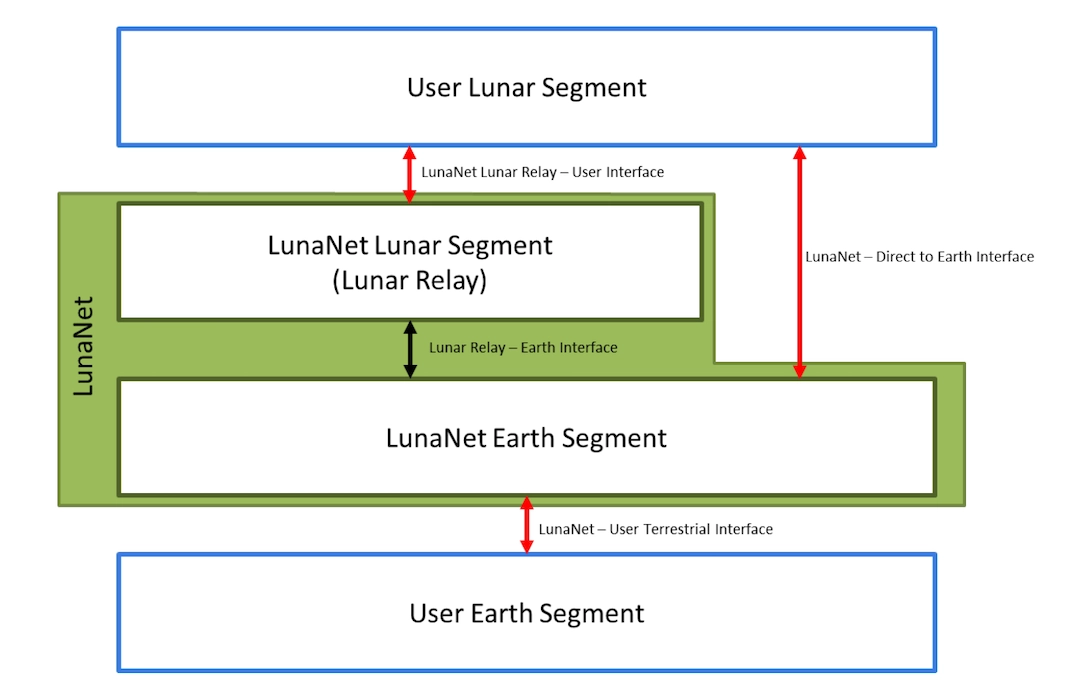
LunaNet segments, from the LunaNet draft Interoperability specification v4
LunaNet will provide communications, positioning, navigation and timing (PNT) and other services to users on and around the Moon (User Lunar Segment) and users' associated systems on Earth (User Earth Segment). As such, LunaNet has a Lunar and an Earth segment. The Lunar Segment contains elements on the Moon’s surface or on its orbit (e.g. lunar relays or lunar positioning satellites as examples).
The User Lunar Segment might interface with LunaNet via a LunaNet Lunar Relay or directly with a LunaNet Earth Segment (e.g. via a Direct to Earth link).
Much like Internet on Earth, it is expected that LunaNet will be built upon multiple LunaNet Service Providers (LNSP) that work in combination to provide services to users. In order to achieve this goal, there are two types of LunaNet interoperable interfaces: LNSP - User Interfaces and LNSP - LNSP Interfaces.
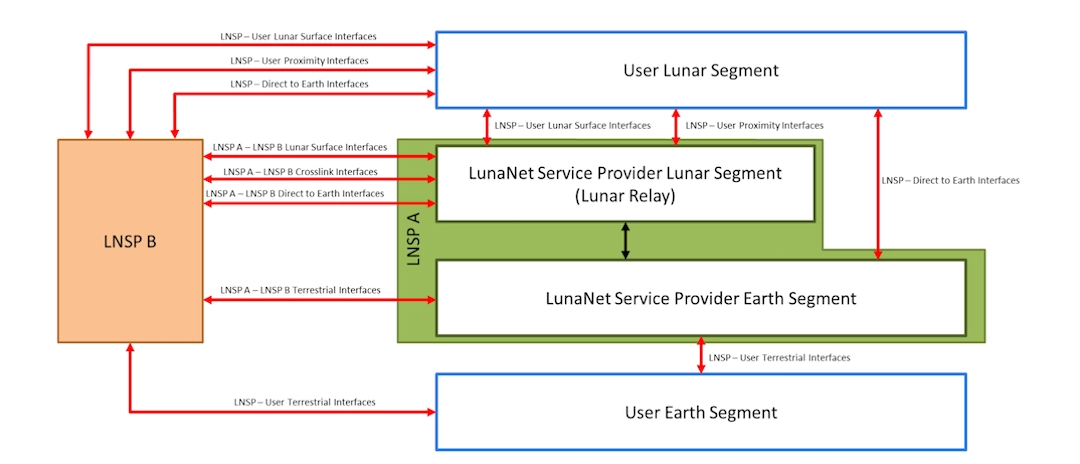
LunaNet Service Provider Interfaces, from the Interoperability specification.
Each logical (link) interface is mapped to link technologies and its associated frequencies. For many of the interfaces, a (new) optical link option is proposed, however its details are not available yet.
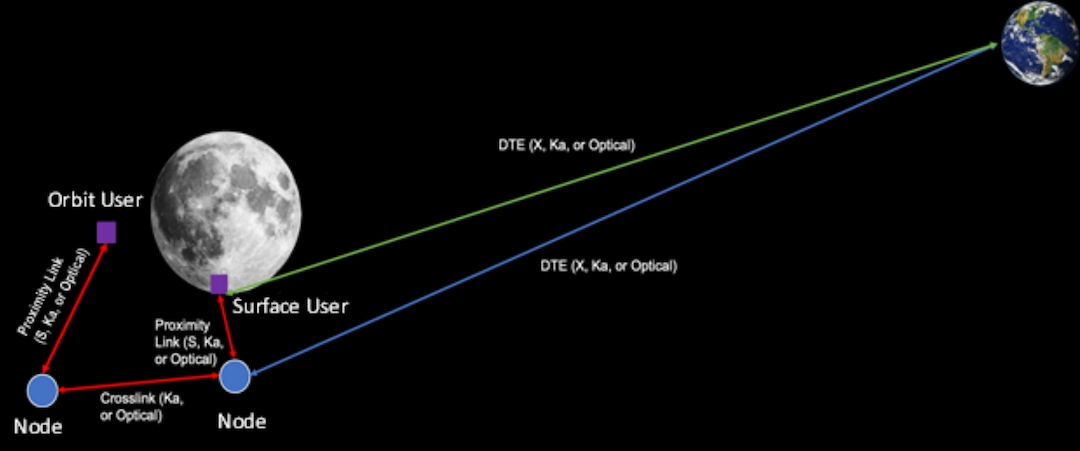
Functional links and corresponding frequency bands, from the Interface specification.
List of interfaces, and their associated technologies.
| Interface Name | Description | Associated Technologies* |
|---|---|---|
| LNSP - User Lunar Surface Interfaces |
Surface to surface interfaces between user and provider, including short-range wireless networks, and short-to-medium range wireless networks with mobility and roaming. | Wi-Fi 6, AC, N - in 5GHz and 2.4 GHz bands (with restrictions), and 3GPP Rel 16 and higher (LTE and 5G). |
| LNSP - User Proximity Interfaces |
User interfaces with lunar orbiting provider nodes. Including link interfaces for 1-to-1 and 1-to-many for broadcast and multiple access, supporting low, mid and high data rates. | Proximity Forward/Return with options for ranging, broadcast and multiple access in S-band (~2 GHz) and Ka-band (~23 GHz). Optical links are also an option with details to be completed. |
| LNSP - User DTE Interfaces |
DTE - Direct to Earth. Interface between users in the lunar systems and provider earth systems, including the direct links between Earth and the lunar surface and the links between Earth and the lunar relay nodes. Includes traditional point to point links with ranging support. | X-band (7-8 GHz) and Ka-band. Optical links are also an option with details to be completed. |
| LNSP - User Terrestrial Interfaces |
Terrestrial Interfaces between user and provider. | Space Link Extension Return/Forward/Cross support Frames/Transmission Units according to CCSDS specifications. |
| Inter-LNSP Lunar Surface Interfaces |
Lunar surface to surface interface between two LNSP. | Same standards as in the LNSP-User Lunar Surface Interfaces. |
| Inter-LNSP Crosslink Interfaces |
Interfaces between two LNSP's lunar orbiting nodes. | High rate Space to space links, according to CCSDS recommendation, on Ka-band. Optical links are also an option with details to be completed. The crosslinks shall be based on the DTN Bundle Protocol for the network layer. |
| Inter-LNSP DTE Interfaces |
Interfaces between an LNSP lunar system and a different LNSP earth system. | Same standards as in the LNSP-User DTE Interfaces. |
| Inter-LNSP Terrestrial Interfaces |
Terrestrial interfaces between two LNSPs. | Same standards as in the LNSP-User Terrestrial Interfaces. |
*This is a very high level summary, refer to the interoperability specification for further details.
LunaNet Interoperability for User Services
LunaNet will provide its users with Communication, PNT, Detection and Information, Science, and Access services.
Communication Services will enable customers with data delivery between source and destination. There are three types of services: Real-time, Store-and-Forward and (LunaNet) Messaging. The user applications are expected to be network based using the Internet Protocol (IP) or the Bundle Protocol (BP). Some LunaNet messaging services are expected to use the link layer using the CCSDS Advanced Orbiting Systems (AOS) standard. The CCSDS Unified Space Data Link Protocol (USLP) is expected to be used at a later phase.
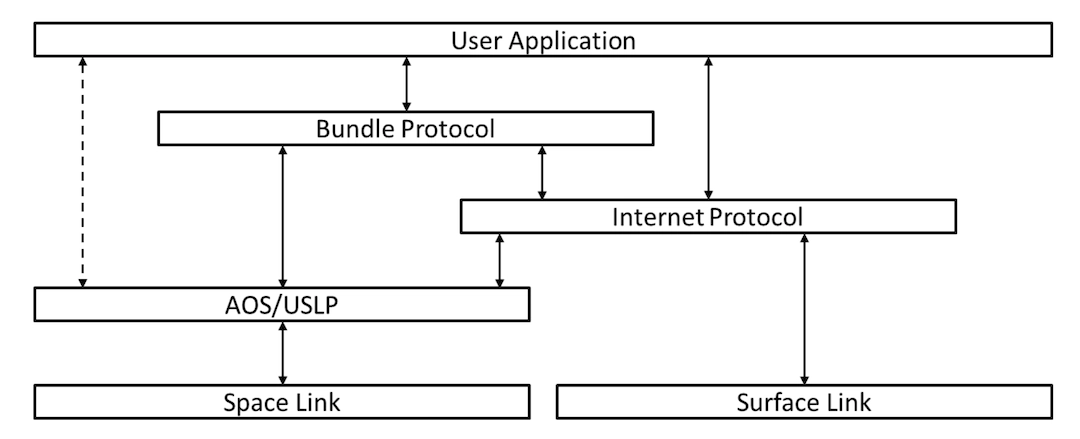
User Application protocol stack, from the interoperability specification.
The following are the main specifications applicable to the Communications service types.
| Communications - Type of service |
Interface description |
|---|---|
| Real-time services | IP packets over current terrestrial standards for all LunaNet terrestrial standard-based interfaces. |
| Real-time services for LunaNet messaging services | IP over CCSDS Encapsulation using the Advanced Orbiting Systems (AOS) standard. The CCSDS Unified Space Data Link Protocol (USLP) is expected to be used at a later phase. This is used for all AOS link layer service interfaces. |
| Store-and-forward services | Bundle Protocol - BP (version 7), using the following convergence layer options: TCPCL, UDPCL, LTPCL and EPPCL (Encapsulation Packet Protocol). |
| Messaging Services | Used by LunaNet specific applications or protocols including service access, PNT, and alerts over user links, LNSP crosslinks, and DTE links. Messages can be carried over Link (AOS frames), IP, BP or the Augmented Forward Signal (AFS). |
PNT Services enable missions to determine position, velocity, surface location, plan trajectories, execute maneuvers and maintain accurate time. Interoperability will be achieved by providing standard signals for Doppler, ranging, timing and standards messages and protocols for the exchange of measurements and products. One of the key objectives is to deliver, through LunaNet, a Global Navigation Satellite System (GNSS)-like capabilities for lunar PNT services, much similar to GPS on Earth and its orbit.
In LunaNet, the PNT services will be delivered through two link/system categories:
- Dedicated Links, which are PNT services provided by direct links between the user and the provider. A dedicated link can provide e.g. a Reference Signal for PNT for Doppler and ranging purposes.
- Lunar Augmented Navigation System (LANS), delivered through multiple nodes, in a similar way as GNSS. This service will be provided in the S-band via the Augmented Forward Signal (AFS).
In an initial phase, it is expected that LANS PNT services would be available in the South Pole (75 degrees latitude) and up to an altitude of 200 kilometers, supporting the users on the Moon's surface and those in low lunar orbit or in transit to/from the surface. In future, it is expected a LANS PNT service delivered across all latitudes and altitudes.
Detection and Information Services support alerts and critical information for user operations, including space weather alerts (automatically) triggered and Lunar Search and Rescue (LunaSAR) beacon detection/location. These services will have standard messages specific to their functions.
For example, LunaSAR services enable users to report location and distress information via internationally recognized messaging standards, using user DTE and Proximity links.
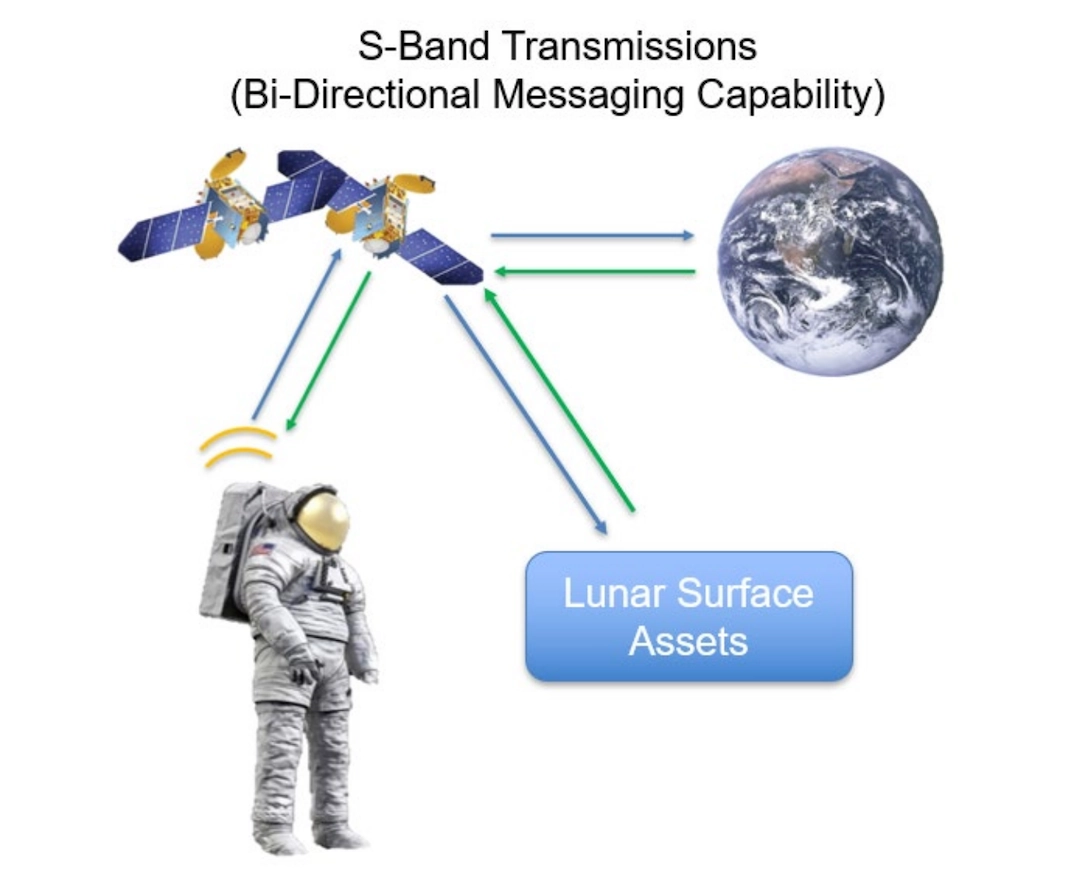
LunaSAR Data Path Concept of Operations, from the interoperability specification.
Science Services are going to be supported by LunaNet using available radio/optical links and telemetry. Some science services may require that LunaNet nodes operate in special mode within the capabilities of the communications and the navigation equipment subsystems to, for example, execute specific physical measurements. These services may require standardized message formats (which will need to be specified) to collect and share these measurements.
Users' Access to LunaNet Services will be achieved through a variety of methods including LNSP pre-scheduled services through mission operations, using multiple access links for non-scheduled “immediate” access or through user initiated services (UIS). It is also expected that capabilities to schedule services between LNSP will be standardized.
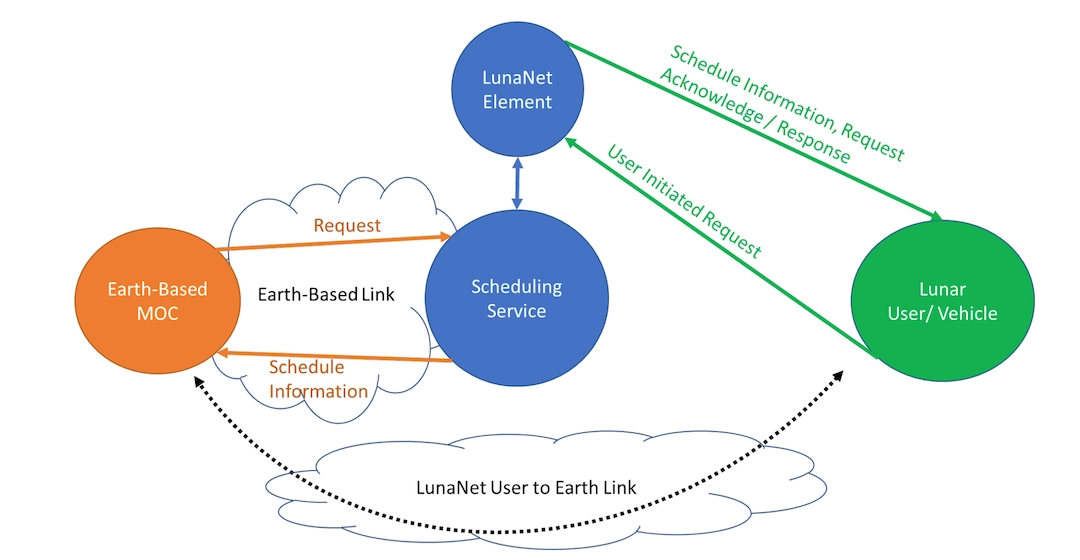
LunaNet Scheduling interfaces, from the interoperability specification.
Delay and Disruption Tolerant Networking (DTN) and LunaNet
DTN - via the Bundle Protocol (BP) is specified in the interoperability specification as one of the networking options for applications on LunaNet, together with IP. In addition, it is mentioned that the Bundle Protocol is the only method to guarantee end-to-end delivery to any network user in LunaNet.
The Bundle Protocol must be supported in inter-LNSP Cross-link to guarantee data delivery.
In terms of security, The Bundle Protocol Security (BPSec) must be implemented between BP nodes.
Although it is not explicitly mentioned, and unless there are new technical requirements, it is expected LunaNet will standardize on the latest version of the Bundle Protocol, version 7.
Roadmap
What's next? There is a large list of open items that have been identified, becoming key specification (and in some cases research) areas to drive completeness of the specifications. The current version of the specification list more than 60 potential new areas to be refined or completed, ranging from physical layer characteristics to the definition of application messages. NASA, ESA and the LunaNet community will continue working to advance the specifications.
In terms of implementation, the specification document depicts the following services as required for the LunaNet Initial Operation Concept (IOC).
| Service |
|---|
| Communications |
| Real-time Link Layer Communications Services |
| Real-time Network Layer Communications Services |
| Store-and-forward Communications Services |
| PNT |
| One-Way Doppler Reference |
| Pseudo-Range and Timing Reference |
| Time-Transfer Reference |
| Lunar Augmented Navigation System (LANS) - 75 degree latitude |
| Two-way Doppler Measurement |
| Range Measurement |
| Supplemental Navigation Products |
| Access |
| Earth-based Scheduling Interface |
| Multiple-Access Forward Link / AFS Service |
| Interfaces |
| LNSP-User Lunar Surface |
| LNSP-User Proximity Interfaces (PFS1a-c, PFS5, PRS1a-c, PRS5, PFKa1, PRKa1) |
| LNSP-DTE Interfaces (XU1, XD1, KaU1, KaD1) |
| LNSP-User Terrestrial Interfaces |
At Spatiam, we are currently building our DTN Platform compliant with LunaNet, enabling users to connect and transfer data efficiently on and around the Moon, and between the Moon and Earth, supporting multi-administration and multi-implementation network overlays. Stay tuned for more updates!
